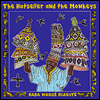|
The Hatseller and the Monkeys

Last updated Friday, July 20, 2007
Author: Baba Wague Diakite
Illustrator: Baba Wague Diakite
Date of Publication: 1999
ISBN: 0590960695
Grade Level: 2nd (GLCs: Click here for grade level guidelines.)
Date(s) Used: Jan. 2006
Synopsis:
A West African version of the beloved folktale about a peddler whose hats are stolen by monkeys. The story has been fleshed out a bit with African words and background about the hatseller's life. Hurrying to a festival, BaMusa does not take time to eat breakfast. When he takes a nap beneath a tree, playful monkeys steal his wares. After being showered with mangoes, the man has a snack and figures out how to get his hats back. The moral is: "it is with a full stomach that one thinks best."
| Discussion topics for before reading: |
| • |
Look in the Author?s Note for the pronunciation of
BaMusa?s song - practice it with the children so they
can say it with you as you read.
|
| • |
What adventures do you think a seller of hats can
get into with monkeys?
|
| • |
This is a story from West Africa. Where is that?
|
| • |
Ever heard the expression, monkey see, monkey do?
What does that mean?
|
| Discussion topics for during/after reading: |
| • |
Take a moment to look at the monkeys around the
pages of the book. What are they doing?
|
| • |
How are the hats made?
|
| • |
What do you think the important secret for success
is?
|
| • |
Why was BaMusa so sleepy?
|
| • |
What would you have tried in order to get the
monkeys to give back the hat?
|
| • |
Why was BaMusa making bad decisions?
|
| • |
What was the lesson that BaMusa learned from the
monkeys?
|
| • |
What does ?an empty satchel cannot stand? mean?
Can you think of another way to say it? How is it
true in your life?
|
| Craft ideas: |
| • |
Make a hat as in the book, either a wide-brimmed
dibiri hat, or a close fitting fugulan hat. Use paper
to make the cone like, or box-like shapes.
|
| • |
What is your favorite saying? (What does your
mother always say?) Draw that in a picture.
|
| Special activities: |
| • |
Play Monkey See, Monkey Do (Simon Says).
|
*Note: These craft ideas are just suggestions.
You can use them, but you don't have to use them.
You can expand upon them, or add your own twist.
Remember, though, that the focus of your time should
not be on the development and execution of a craft;
the focus should be on the read-aloud and the
enjoyment of the book!
|
